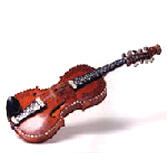Moreover, the sympathetic strings vibrate together with the upper main strings when the main strings are bowed, which creates the instrument's special sound. In addition, the bridge is flatter, making it easier to bow two or perhaps three strings simultaneously.
The origin of the hardingfele is a major topic of discussion. One theory holds that it developed from European instruments such as the violin and the viola d'amore (a fiddle type from the gamba family with sympathetic strings).
Another theory holds that the hardingfele is a further development of the medieval bowed instruments fidla and gigja.
The oldest hardingfele may be the Jaastadfela from Hardanger, dated 1651 and located in the Bergen Museum, although this has been disputed. In any case the earliest hardingfeler were made in the area of Hardanger. In the eighteenth century the hardingfele spread from Hardanger to surrounding areas. Today the hardingfele is mainly used in the areas of Vestland, Telemark, Numedal, Hallingdal, Valdres and Setesdal.
The hardingfele is characteristically decorated with mother of pearl inlay and pen and ink acanthus designs on the top, sides and bottom.
Traditionally the hardingfele is a solo instrument used for dance playing, listening tunes and song melodies, but recently it has become more common to use hardingfele in ensembles.
The origin of the hardingfele is a major topic of discussion. One theory holds that it developed from European instruments such as the violin and the viola d'amore (a fiddle type from the gamba family with sympathetic strings).
Another theory holds that the hardingfele is a further development of the medieval bowed instruments fidla and gigja.
The oldest hardingfele may be the Jaastadfela from Hardanger, dated 1651 and located in the Bergen Museum, although this has been disputed. In any case the earliest hardingfeler were made in the area of Hardanger. In the eighteenth century the hardingfele spread from Hardanger to surrounding areas. Today the hardingfele is mainly used in the areas of Vestland, Telemark, Numedal, Hallingdal, Valdres and Setesdal.
The hardingfele is characteristically decorated with mother of pearl inlay and pen and ink acanthus designs on the top, sides and bottom.
Traditionally the hardingfele is a solo instrument used for dance playing, listening tunes and song melodies, but recently it has become more common to use hardingfele in ensembles.


